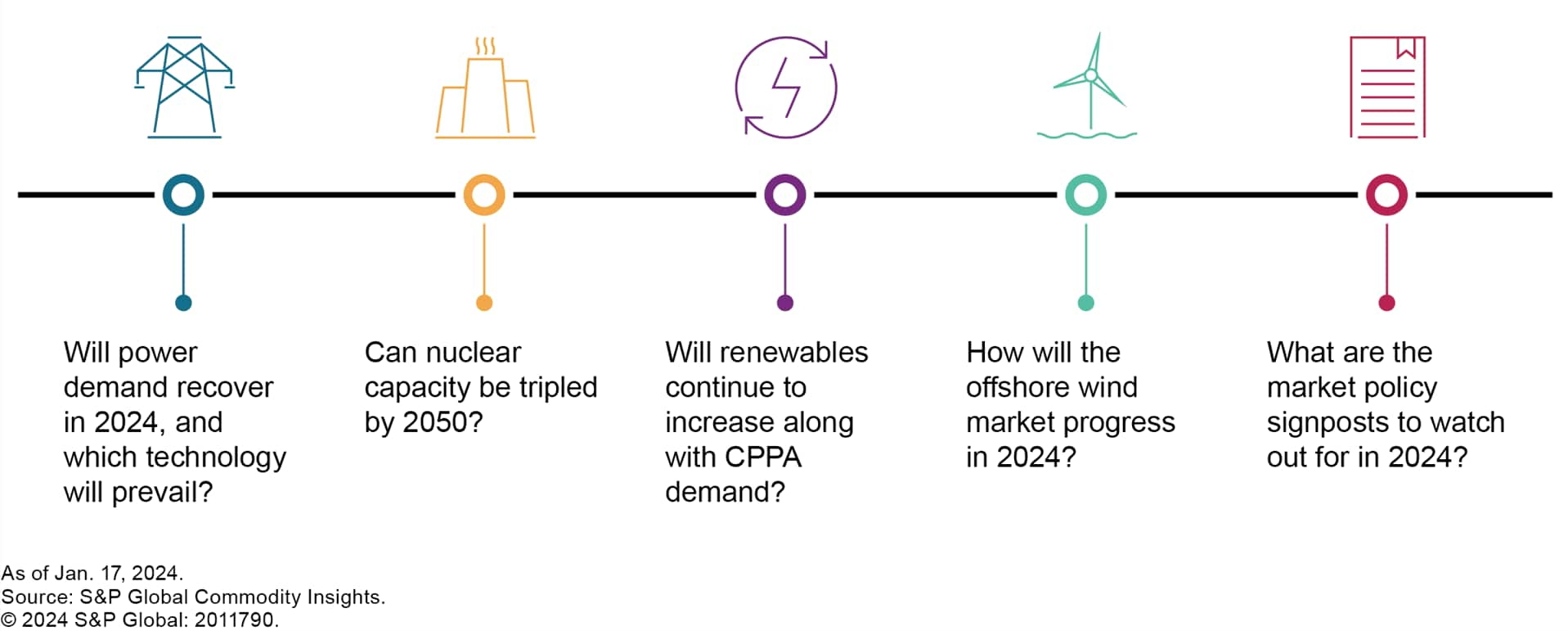Five big questions for OECD Asia’s gas and power market in 2024
The list of unprecedented events grew in 2023 — the conflict in Gaza added further tension to an already-strained global commodity trade, summer temperatures hit record highs and wildfires and floods pushed global warming solutions to the top of the world's agenda. The year ended with the UN Climate Change Conference, or Conference of the Parties (COP28), where several pledges were announced that could accelerate the pace and landscape within the energy industry.
As 2024 unravels, S&P Global Commodity Insights lays out five big questions that are expected to shape the discussions around the gas and power market in Australia, Japan and South Korea.

Will power demand recover in 2024, and which technology will prevail?
In Australia, power demand was down 0.6% year on year (the first decline since 2020) in 2023 as the nation recorded the warmest winter on record and vacancies remained above pre-pandemic levels in the commercial sector. Power demand was particularly low in Japan - January-December 2023 on-grid demand was down 3.2% year on year as a result of headwinds from sluggish external demand, and yen depreciation and consumer price inflation of 3.2% suppressed activities in what was meant to be a recovery after all COVID-19-related restrictions were lifted. South Korea's power demand declined by 1% in 2023. While a slower economy contributed to the lower demand, the government also implemented an energy savings campaign in late 2022, where public offices aimed for demand cuts of 10%, energy efficiency in households was targeted and major companies were asked to set energy savings goals.
Will a recovery in economic activities lead to a recovery in power demand, and will thermal generation maintain market share?
Can nuclear capacity be tripled by 2050?
At COP28, a declaration was made by 22 nations (including Japan and South Korea) to accelerate the deployment of low-emission technologies, including tripling nuclear energy capacity versus 2020 levels by 2050. The declaration recognizes nuclear as one of the key low-carbon technologies to keep the world aligned to the 1.5-degree goal and implies that the total installed nuclear capacity of about 375 GW in 2020 will increase to more than 1,125 GW by 2050.
Are lifetime extensions going to be granted to the existing nuclear fleet in Japan and South Korea, and will the government of South Korea support new reactors?
Will renewables continue to increase along with CPPA demand?
High demand from corporate offtakers continue to drive growth in the renewable PPA market in 2023 with a year-on-year increase in contracted capacity in Australia and South Korea, while Japan recorded a larger number of smaller sized offtake agreements. However, supply challenges are starting to emerge in all three markets — creating a roadblock for unwavering demand. The market is restricted by a shortage of suitable land for development in Japan and South Korea for large projects, accompanied by escalating costs and heightened financial risks in Japan and a lack of government policy support in South Korea. In Australia, the renewable project pipeline has slowed thanks to a downturn in project investment owing to increased financial risk amid rising costs, lower captured prices and challenges connecting to the grid.
Will new government policies create financial incentives and clear regulatory roadblocks to enable project development and boost supply for the CPPA market?
How will the offshore wind market progress in 2024?
In OECD Asia, offshore wind is emerging as an alternative source that could decarbonize the power sector and contribute to achieving NDC targets. The development of this emerging sector maintained its momentum in 2023 with competitive tenders held in Japan and South Korea, and the advancement toward feasibility licenses in Australia. Japan's round 2 of the offshore wind tender concluded on Dec. 13, 2023, with shockwaves rippling through from the news that the winning bid came at zero premium levels in three out of the four grids offered. South Korea has just closed the first offshore wind competitive bidding for a long-term REC price contract, with five project consortiums of 1.4 GW combined capacity awarded in December 2023. In Australia, the government received 45 feasibility license applications for two offshore wind zones, two additional zones are under final consideration and a fifth is open for consultation.
With supply chain disruptions and a high interest rate environment continuing to put a strain on the cost of offshore wind projects, the question remains whether projects could successfully reach financial close.
What are the market policy signposts to look out for in 2024?
Australia
- The government's recently expanded Capacity Investment Scheme (CIS), targeting 32 GW of new capacity, is among the most significant steps in advancing renewable capacity additions since the 2001 renewable energy target. The expanded CIS scheme will be rolled out in 2024-27, with regular competitive tenders conducted every six months.
Japan
- Japan will begin a review of its principal energy policy, the Strategic Energy Plan, starting in 2024. The upcoming review is expected to look at changes in the energy landscape, including demand outlooks from emerging sectors such as IT, and is also likely to add an interim outlook for 2035.
South Korea
- South Korea is expected to announce the 11th BPE in 2024 — set to guide the country's electricity mix for 2024-38. The question remains whether the renewable energy target will continue to be moderated, a trend that has continued over the past two years under the current administration.
- The first clean hydrogen auction is set to open in second quarter 2024 for 6,500 GWh bidding capacity. The subsidy plans, clean hydrogen certification scheme and final auction design are expected to be announced in the first half of 2024, which will become a crucial guide for potential bidders in formulating hydrogen sourcing strategy.
If you are interested in learning more about our Asia-Pacific gas, power and renewables coverage, please click here.
This article was published by S&P Global Commodity Insights and not by S&P Global Ratings, which is a separately managed division of S&P Global.




